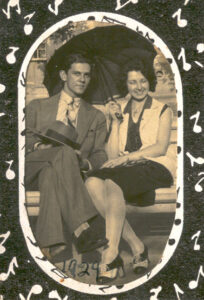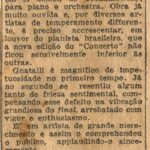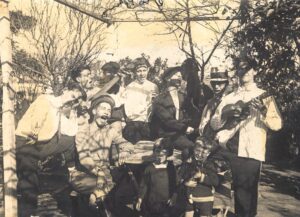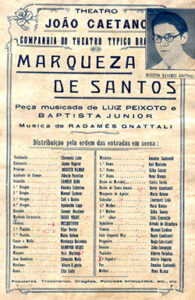- Radamés married Vera Maria Bieri, a trained pianist from São Leopoldo (RS), his partner for 33 years, with whom he had two children, Alexandre and Roberta.
 Radamés and Vera
Radamés and Vera- Conducted by Francisco Braga, Radamés performs Tchaikovsky’s Concerto in B flat [1] at the Theatro Municipal in Rio de Janeiro.

” Symphonica’s first Assignatura concert.
- Unable to survive in Rio de Janeiro only as a concert pianist and composer of classical music, Radamés begins to work in the popular music market playing piano or viola in film and dance orchestras.
Popular music was already part of his day-to-day life since Porto Alegre, where he participated in choro and samba ensembles and in the “Ideal Jazz Band”.
In the photo, Radamés is the one with the cavaquinho, on the right.
- Pianist Dora Bevilacqua performs the Brazilian Rhapsody (1930), by Radamés, at the Instituto Nacional de Música.
- On October 21, the Companhia de Theatro Typico Brasileiro premieres, at the Theatro João Caetano, in Rio de Janeiro, the musical play
Marquesa de Santos
by Luís Peixoto and Baptista Júnior, with music and conducting by Radamés Gnattali.
- On November 18, at Theatro João Caetano, replacing the Marquesa de Santos, the great Companhia de Teatro Typico Brasileiro premiered the costume play, in 2 acts and 6 paintings, Sertão, by Jayme Ovalle and Radamés Gnattali, the latter, author of songs and conductor.
- Also in November, the Brazilian Artists Association, in its 10th concert, auditions compositions by Radamés and Luiz Cosme; among the performers, besides the authors, are violinist Oscar Borgerth and cellist Iberê Gomes Grosso.
- Radamés is hired by the recording company Victor Talking Machine Co. of Brazil as pianist of the orchestras Típica Victor, Diabos do Céu and Guarda Velha, under the direction of maestro Alfredo da Rocha Vianna Filho (Pixinguinha).
- The clarinetist, saxophonist, composer and arranger Paulo Moura (Paulo Gonçalves de Moura) to whom Radamés dedicates, in 1959, was born in São José do Rio Preto (SP),
Sad waltz
in 1959, among a series of pieces for alto saxophone and piano.
Radamés composes:
-
- Acalanto for chamber orchestra
- Nêgo veio tá sonhando (batuque) for cello and piano – dedicated to Iberê Gomes Grosso
- Serestas No. 2 for string quartet
- The first competitive parade of Rio de Janeiro’s samba schools takes place at Praça Onze, and the Estação Primeira de Mangueira wins.
- Villa-Lobos takes over as director of SEMA – Superintendency of Musical and Artistic Education, a normative and pedagogical body of the new federal government. He stays in office until 1945.
- Civil war breaks out between São Paulo and the Getulista forces, known as the Constitutionalist Revolution, ending with the defeat of the oppositionists.


